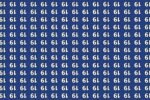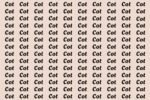When it comes to optical illusions, they are often more than just a fun exercise for your eyes. They can test your mental agility, challenge your focus, and even help you improve cognitive functions like concentration and pattern recognition. Among the many optical illusions floating around the internet, one particular test stands out for its ability to baffle even the most eagle-eyed individuals: the Optical Illusion IQ Test, where participants are tasked with spotting the number 6342 among a sea of 6432s.
In this article, we’ll dive into the mechanics behind the illusion, explore why it’s so difficult to spot the right number, and provide tips on how you can enhance your skills to tackle similar challenges in the future. So, let’s get started and see if you can spot the number 6342!
Understanding the Optical Illusion Test
At first glance, the challenge seems simple enough. You are presented with a grid or a page filled with various numbers, where one number, 6342, is hidden amongst a series of 6432s. All the numbers look nearly identical except for one subtle difference: the digits are arranged in a slightly different order.
It sounds easy, right? After all, you’re just looking for one number in a sea of similar ones. But when you start scanning the array, things aren’t so clear. The problem lies in the way our brains process visual information, especially when it comes to recognizing patterns. Our brain tends to pick up on familiar configurations faster than unfamiliar ones. In this case, the number 6432 is the more familiar arrangement, and it dominates our perception, making it harder to spot the scrambled number 6342.
Why is it so difficult to spot the number 6342?
To understand why this illusion is so tricky, we need to explore how our brains process visual stimuli. When we look at a grid filled with numbers, we’re not simply scanning each digit one by one. Instead, our brains use pattern recognition to quickly identify common structures. In this case, 6432 is the familiar pattern for most people, while 6342 is the outlier.
The order of the digits in 6432 forms a natural progression for our minds. We’ve seen this pattern countless times, whether in clocks, dates, or even in certain numerical sequences. When we scan the grid, our brains are more likely to focus on the familiar sequence, making it harder to detect the scrambled version of the number.
Additionally, the illusion plays with our sense of expectation. When we know we are looking for something specific, like 6342, our brains can sometimes trick us into thinking we’ve spotted it, even if we haven’t. This leads to overconfidence and errors in judgment. You might find yourself staring at the grid for minutes, convinced that you’ve spotted the number, only to realize later that you’ve missed it entirely.
The Role of Cognitive Bias in Optical Illusions
The difficulty in solving optical illusions is not just a matter of visual processing; it also involves cognitive biases. Cognitive biases are mental shortcuts or “rules of thumb” that our brains use to simplify decision-making. While these biases can be helpful in everyday life, they can also cause us to make mistakes in situations where accuracy is paramount.
In the case of this optical illusion, one cognitive bias at play is the confirmation bias. This bias occurs when our brains actively seek out information that confirms what we already believe or expect. In this instance, once we identify a 6432 in the grid, our brains tend to focus on similar patterns, often overlooking the subtle differences in the sequence that would point us to the correct number, 6342.
Another bias that might come into play is the familiarity effect. When we see a number like 6432 repeatedly, we become accustomed to it. This familiarity makes us less likely to notice minor deviations, like the rearrangement of digits in 6342. Our brains, in an attempt to be efficient, tend to dismiss these deviations as irrelevant, which makes the illusion all the more challenging.
How to Improve Your Ability to Spot Optical Illusions
While some optical illusions are designed to be nearly impossible to solve, most people can improve their ability to spot hidden patterns and numbers with a little practice. Here are some tips to help you enhance your optical illusion-solving skills:
- Focus on Details: Instead of quickly scanning the entire grid, focus on one small section at a time. This allows your brain to process the information in smaller chunks and reduces the risk of missing subtle differences.
- Avoid Rushing: Optical illusions can be tricky, and rushing through them often leads to mistakes. Take your time and double-check the numbers before assuming you’ve found the right one.
- Train Your Brain with Other Illusions: If you find this optical illusion challenging, try solving other similar tests to build your mental agility. Regularly practicing with different types of optical illusions can help you improve your pattern recognition skills over time.
- Change Your Approach: If you’ve been staring at the grid for a while without success, try shifting your focus to a different part of the page or looking at it from a different angle. Sometimes a change in perspective is all it takes to spot the hidden number.
- Stay Calm and Patient: The longer you look at a challenging optical illusion, the more likely your brain is to experience cognitive fatigue. Taking short breaks or looking away for a moment can help reset your brain and allow you to come back with fresh eyes.
The Science Behind Optical Illusions
At their core, optical illusions highlight the fascinating ways our brains process visual information. What you see isn’t always what’s actually there. Optical illusions exploit gaps in our perception and understanding of how images and patterns are constructed.
In the case of the 6342/6432 illusion, your brain’s tendency to favor familiar patterns plays a significant role. The same phenomenon occurs in many other types of optical illusions, whether it’s a figure that appears to be moving when it’s stationary, or a color contrast that isn’t actually as stark as it seems. The field of psychology that studies these phenomena is known as cognitive neuroscience, and researchers have spent decades trying to understand why our brains sometimes misinterpret visual stimuli.
Conclusion
The Optical Illusion IQ Test, where you must find the number 6342 among a bunch of 6432s, is a fun yet challenging test that offers more than just entertainment it helps you improve cognitive abilities like attention, pattern recognition, and concentration. By understanding how your brain processes visual information and recognizing the cognitive biases at play, you can enhance your ability to solve similar illusions in the future.
So, the next time you come across an optical illusion, don’t just rush through it. Take your time, stay patient, and see if you can train your brain to recognize even the most subtle differences. Who knows? You might just discover a hidden talent for solving optical illusions that you never knew you had!




